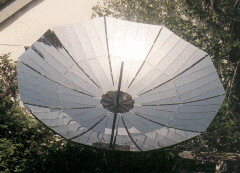
The cost and availability of residential 3-meter (10-foot) tracking dish antennas can be referenced in the global market from local TV vendors.
The time-based solar energy performance of a tracking solar dish concentrator can be estimated from historical climate data compiled by The National Renewable Energy Laboratory (NREL).
Estimated costs for off-the-shelf parts from local
venders:
3-meter diameter dish $500
Tracking arm $50
Support Post $50
Glass mirror $100
Black copper coil receiver $50
Solar tracking electronics $25
Overhead $175
Total cost $950.
Net aperture area - 7 square meters. $135 per square meter ($12.65/sq. foot)
At 5 kilowatts (thermal) output the cost is $190/kW or $0.19/watt
Balance of system costs are not included because of the variability of system designs. More than one dish may be connected to one system. Additional pumps and storage tanks would not be needed in district heating systems and in high load applications.
Estimated annual efficiency
Concentrator: glass mirror 85% * black painted receiver 95% * thermal loss
90% = 72%
Site: solar availability after shadows 80% * dirt 90% * thermal inertia 95%
* 72% = 50%
Annual efficiency could be better or worst depending on the site, dish operating temperatures, and maintenance. Annual performance will decrease if not all of the energy is consumed. Flat glass square mirrors 10 X 10 cm (4 X 4 inch) yield a solar concentration ratio greater than 100 to 1. Solar steam is possible. Be sure to use pressure relief valves. The mirrors will not exceed engineered high wind loads nor gravity snow loads. TV dishes are polar mounted. The consumer would need to make periodic dish declination adjustments as the sun moves from the summer to the winter solstice (+/- 23 degrees off the equinox). Operation and maintenance cost should average 1% to 3% of capital cost per year over the first 20 years.
Annual performance can be predicted from solar data tables for various locations. The following link is a good source for calculating the solar resource for a mix of fixed and tracking solar collectors. Solar Data
For example, a two-axis tracking concentrator solar collector in Boulder CO. could expect to see an average of 5.4 kilowatt hours per square meter per day or 1971 kWh/m^2/year. Multiplying 1971 kWh/m^2/year by 7 m^2/dish and 50% annual efficiency yields 6900 kWh/year/dish delivered energy in Boulder. The same method yields 3700 kWh/year/dish in Seattle and 8700 kWh/year/dish in Phoenix.
Return on investment depends on the value of the energy displaced. Generally, residential fossil fuel consumers of gas and oil pay $0.01 to $0.02 per kWh ($3 to $6 per MMBTU) after burner efficiency. Residential electricity consumers pay $0.05 to $0.15 per kWh. Industrial consumers pay about half as much as residential consumers.
Displacing just 1% of electrcal consumption in the USA would require at least $10 billion for solar thermal hardware.
A 3-meter dish in Boulder producing 6900 kWh/year displacing electricity valued at $0.07/kWh would be worth $483/year. Divided by the capital cost of $950 the return on investment would be 51% per year, less operation and maintenance expenses. Return on investment displacing fossil fuels would be 7% to 14%.
Return on investment in Seattle climate displacing 3700 kWh electricity at $0.05 /kWh is 19%.
Return on investment in Phoenix climate displacing 8700 kWh electricity at $0.09 /kWh is 82%.
A very large solar thermal market could emerge by exploiting a market niche in electrical power displacement. This market potential needs leadership. The current efforts to make electricity with solar power have confused solar consumers. Making electricity with solar energy is 2000% more expensive than displacing electricity with solar energy.
Developers should capitalize on the strengths of solar energy - that it is available globally and it is transported locally to the consumer for free. Solar energy does not need to be converted into electricity and fuel nor transported by wires and pipes to be cost effective. Consumers do not need large infrastructures and utilities to access low cost solar energy.

March 21, 1997